C语言并发编程多线程和多进程
C语言中的并发与同步机制
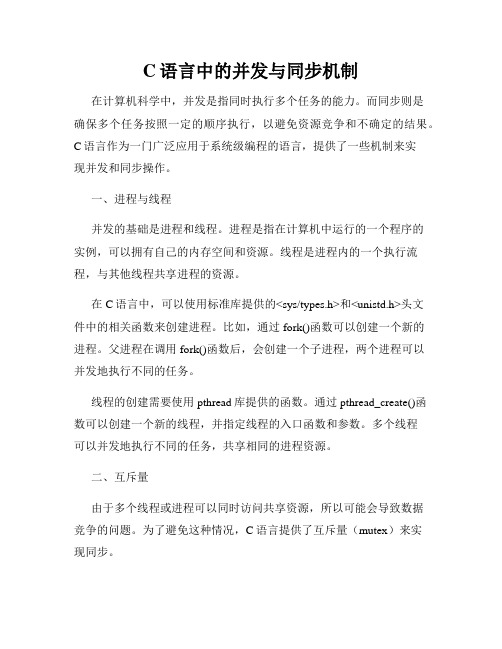
C语言中的并发与同步机制在计算机科学中,并发是指同时执行多个任务的能力。
而同步则是确保多个任务按照一定的顺序执行,以避免资源竞争和不确定的结果。
C语言作为一门广泛应用于系统级编程的语言,提供了一些机制来实现并发和同步操作。
一、进程与线程并发的基础是进程和线程。
进程是指在计算机中运行的一个程序的实例,可以拥有自己的内存空间和资源。
线程是进程内的一个执行流程,与其他线程共享进程的资源。
在C语言中,可以使用标准库提供的<sys/types.h>和<unistd.h>头文件中的相关函数来创建进程。
比如,通过fork()函数可以创建一个新的进程。
父进程在调用fork()函数后,会创建一个子进程,两个进程可以并发地执行不同的任务。
线程的创建需要使用pthread库提供的函数。
通过pthread_create()函数可以创建一个新的线程,并指定线程的入口函数和参数。
多个线程可以并发地执行不同的任务,共享相同的进程资源。
二、互斥量由于多个线程或进程可以同时访问共享资源,所以可能会导致数据竞争的问题。
为了避免这种情况,C语言提供了互斥量(mutex)来实现同步。
使用互斥量可以将对共享资源的访问限制在一个线程或进程中,其他线程或进程需要等待当前线程或进程释放该资源后才能访问。
在C语言中,可以使用pthread库提供的函数来操作互斥量。
比如,通过pthread_mutex_init()函数初始化一个互斥量,并使用pthread_mutex_lock()和pthread_mutex_unlock()函数来加锁和解锁互斥量。
三、条件变量条件变量(condition variable)用于在多个线程之间传递信息,通常与互斥量一起使用来实现线程之间的同步和通信。
C语言中的pthread库提供了条件变量的相关函数。
通过pthread_cond_init()函数初始化一个条件变量,并使用pthread_cond_wait()和pthread_cond_signal()函数来等待和触发条件变量的变化。
c语言程序设计与现代方法

c语言程序设计与现代方法C语言程序设计与现代方法随着计算机科学和技术的快速发展,C语言作为一种广泛应用的编程语言,对于现代程序设计方法的理解和应用变得越来越重要。
本文将介绍C语言程序设计的现代方法,包括模块化编程、面向对象编程、并发编程和测试驱动开发等方面的内容。
一、模块化编程模块化编程是一种将复杂的程序分解为独立的模块,每个模块完成特定任务的编程方法。
在C语言中,可以通过函数来实现模块化编程。
通过将一个大型程序分解为多个小的函数,可以提高代码的可读性和可维护性。
同时,模块化编程也使得多人协作开发变得更加容易,每个人负责不同的模块,最后进行整合。
二、面向对象编程面向对象编程是一种以对象为基础,通过封装、继承和多态等机制来组织和管理程序的编程方法。
虽然C语言本身并不直接支持面向对象编程,但可以通过结构体和函数指针等技术来实现类似的效果。
通过将数据和操作封装在结构体中,可以实现数据的隐藏和封装,提高代码的可靠性和复用性。
三、并发编程随着多核处理器的普及,程序的并发性变得越来越重要。
并发编程是一种利用多线程或多进程并行执行任务的编程方法。
C语言提供了多线程和进程管理的相关库函数,可以方便地实现并发编程。
通过合理地设计和管理线程或进程,可以提高程序的性能和响应速度。
四、测试驱动开发测试驱动开发是一种在编写代码之前先编写测试用例的开发方法。
通过先编写测试用例,可以明确代码的功能和需求,减少后期的调试和修复工作。
在C语言中,可以使用各种单元测试框架来实现测试驱动开发。
通过编写和执行测试用例,可以提高代码的质量和稳定性。
总结C语言程序设计与现代方法密不可分,模块化编程、面向对象编程、并发编程和测试驱动开发等方法在实际开发中起到了重要作用。
通过合理运用这些方法,可以提高代码的可读性、可维护性和性能,从而更好地满足现代程序设计的需求。
因此,对于学习和掌握这些现代方法,对于C语言程序员来说至关重要。
C语言中的并发编程技巧

C语言中的并发编程技巧在计算机科学领域,并发编程是指同时执行多个独立任务的能力。
在C语言中,有一些技巧可以帮助我们更好地进行并发编程,提高程序的效率和性能。
本文将介绍一些C语言中的并发编程技巧。
1. 使用线程在C语言中,我们可以使用线程来实现并发编程。
线程是轻量级的执行单元,能够在同一进程中并发执行多个任务。
通过使用线程,我们可以将程序的不同部分并行地执行,以提高程序的性能和响应能力。
2. 使用互斥锁并发编程中,多个线程可能会同时访问和修改共享的数据。
为了避免数据的竞争和冲突,我们可以使用互斥锁来同步线程对共享数据的访问。
互斥锁可以确保同时只有一个线程能够访问共享数据,其他线程需要等待。
3. 使用条件变量条件变量是一种线程间的通信机制,用于等待某个条件的发生。
在C语言中,我们可以使用条件变量来实现线程之间的同步和通信。
通过条件变量,线程可以等待某个条件的满足,并在条件满足时被唤醒。
4. 使用原子操作原子操作是一种不可分割的操作,能够保证多个线程同时对同一变量进行操作时的正确性。
在C语言中,我们可以使用原子操作来避免竞态条件和数据的不一致性。
通过使用原子操作,我们可以保证对于共享变量的操作是原子的,不会被其他线程的干扰。
5. 使用信号量信号量是一种用于多进程或多线程之间同步和通信的机制。
在C语言中,我们可以使用信号量来实现进程或线程之间的互斥和同步。
通过使用信号量,我们可以控制对共享资源的访问和使用。
6. 避免死锁死锁是并发编程中常见的问题,指的是两个或多个线程互相等待对方释放资源而无法继续执行的情况。
为了避免死锁,我们需要合理地设计和使用锁,并确保获取锁的顺序是一致的。
此外,还可以使用资源分配图等方法来检测和预防死锁的发生。
总结在C语言中,通过使用线程、互斥锁、条件变量、原子操作和信号量等并发编程技巧,我们可以更好地实现并发程序。
然而,同时也需要注意避免死锁等问题,确保程序的正确性和稳定性。
通过灵活应用这些技巧,可以提高程序的效率和性能,满足现代计算需求的要求。
c 多线程实现的四种方式

c 多线程实现的四种方式C语言是一种非常流行的编程语言,它可以用来实现多线程编程。
多线程编程可以让你的程序更高效、更快速地运行,因为它可以同时执行多个任务。
在这篇文章中,我们将介绍 C 多线程实现的四种方式。
1. 使用 pthread 库pthread 是一个 POSIX 标准定义的多线程库,它提供了一套API 接口,可以用来实现多线程编程。
使用 pthread,你可以创建多个线程并且控制它们的行为。
这种方式是 C 语言实现多线程的最常用方式之一。
2. 使用 OpenMP 库OpenMP 是一个开源的多线程库,它可以用来在 C 语言中实现多线程编程。
OpenMP 提供了一套 API 接口,可以让你更方便地编写并行程序。
使用 OpenMP,你可以使用 #pragma 指令来控制并行执行的代码块。
3. 使用 POSIX 线程POSIX 线程是一种 POSIX 标准定义的多线程接口,它可以用来实现多线程编程。
与 pthread 类似,POSIX 线程提供了一套 API 接口,可以让你更方便地编写多线程程序。
4. 使用 Windows 线程如果你在 Windows 操作系统上编写 C 语言程序,你可以使用Windows 线程来实现多线程编程。
Windows 线程提供了一套 API 接口,可以让你在 Windows 平台上创建多个线程并且控制它们的行为。
总结以上是 C 多线程实现的四种方式。
在选择使用哪种方式时,你应该考虑自己的需求和使用的操作系统。
不同的方式会有不同的 API 接口、性能和可移植性。
如果你需要了解更多关于 C 多线程编程的知识,可以参考相关的书籍和教程。
C语言并发编程多线程和多进程的应用

C语言并发编程多线程和多进程的应用C语言是一门广泛应用于系统级开发的编程语言,它具备高性能和低级别的特点,常用于操作系统、设备驱动和嵌入式系统的开发。
在实际应用中,多线程和多进程是C语言并发编程的两个重要概念和技术,它们可以提高程序的性能和响应能力。
本文将介绍C语言中多线程和多进程的应用,并探讨它们在不同场景中的优劣和适用性。
一、多线程的应用1. 线程概念及优势多线程是指在一个进程内创建多个并行执行的线程,每个线程可以独立执行不同的任务。
相比单线程程序,多线程程序具有以下优势:- 提高程序的性能:多线程能够将任务拆分为多个子任务,并在多个线程上同时执行,从而减少程序的执行时间。
- 增加程序的响应能力:通过将阻塞操作放在单独的线程中执行,可以避免主线程的阻塞,提高程序的响应速度。
- 使程序结构更清晰:多线程可以提升程序的模块化和可维护性,将不同的功能模块独立封装在不同的线程中,易于理解和扩展。
2. 多线程的创建和同步在C语言中,可以使用标准的线程库如pthread来创建和管理线程。
创建线程的步骤包括线程的初始化、启动和等待线程的结束。
多线程之间的同步可以通过互斥锁、条件变量和信号量等机制来实现。
互斥锁用于保护共享资源的访问,条件变量用于线程之间的通信,信号量则可以用于限制并发访问的数量。
3. 多线程的应用场景多线程适用于以下场景:- 超过单个核心能力的计算任务:通过将任务分解为多个子任务,可以在多个核心上并行执行,提高计算任务的执行效率。
- 服务器应用:通过多线程可以提高服务器的并发处理能力,同时处理多个客户端请求。
- 图形界面程序:通过将耗时操作放在后台线程执行,可以提高界面的流畅性和响应速度。
二、多进程的应用1. 进程概念及优势进程是指一个程序的执行实例,它拥有独立的地址空间和资源。
多进程是指在操作系统中同时运行多个独立的进程,每个进程可以执行不同的任务。
多进程编程的优势包括:- 提高系统的稳定性:通过将不同的任务独立在多个进程中执行,可以避免一个进程的崩溃导致整个系统的崩溃。
C#多线程开发:并行、并发与异步编程

C#多线程开发:并⾏、并发与异步编程概述现代程序开发过程中不可避免会使⽤到多线程相关的技术,之所以要使⽤多线程,主要原因或⽬的⼤致有以下⼏个:1、业务特性决定程序就是多任务的,⽐如,⼀边采集数据、⼀边分析数据、同时还要实时显⽰数据;2、在执⾏⼀个较长时间的任务时,不能阻塞UI界⾯响应,必须通过后台线程处理;3、在执⾏批量计算密集型任务时,采⽤多线程技术可以提⾼运⾏效率。
传统使⽤的多线程技术有:1. Thread & ThreadPool2. Timer3. BackgroundWorker⽬前,这些技术都不再推荐使⽤了,⽬前推荐采⽤基于任务的异步编程模型,包括并⾏编程和Task的使⽤。
Concurrency并发和Multi-thread多线程不同你在吃饭的时候,突然来了电话。
1. 你吃完饭再打电话,这既不并发也不多线程2. 你吃⼀⼝饭,再打电话说⼀句话,然后再吃饭,再说⼀句话,这是并发,但不多线程。
3. 你有2个嘴巴。
⼀个嘴巴吃饭,⼀个嘴巴打电话。
这就是多线程,也是并发。
并发:表⽰多个任务同时执⾏。
但是有可能在内核是串⾏执⾏的。
任务被分成了多个时间⽚,不断切换上下⽂执⾏。
多线程:表⽰确实有多个处理内核,可同时处理多个任务。
⼀、并发编程:使⽤ThreadPool轮询并发⽅法是使⽤⼀个List(或其他容器)把所有的对象放进去,创建⼀个线程(为了防⽌UI假死,由于这个线程创建后会⼀直执⾏切运算密集,所以使⽤TheadPool和Thread差别不⼤),在这个线程中使⽤foreach(或for)循环依次对每个对象执⾏ReceiveData⽅法,每次执⾏的时候创建⼀个线程池线程来执⾏。
代码如下:使⽤Task轮询并发⼆、并⾏编程:private static bool IsPrimeNumber(int number){if (number < 1){return false;}if (number == 1 && number == 2){return true;}for (int i = 2; i < number; i++){if (number % i == 0){return false;}}return true;} 如果不采⽤并⾏编程,常规实现⽅法:for (int i = 1; i <= 10000; i++){bool b = IsPrimeNumber(i);Console.WriteLine($"{i}:{b}");}采⽤并⾏编程⽅法Parallel.For(1, 10000, x=>{bool b = IsPrimeNumber(x);Console.WriteLine($"{i}:{b}");})Parallel类还有⼀个ForEach⽅法,使⽤和For类似。
c语言 多进程和多线程

进程是一个具有独立功能的程序关于某个数据集合的一次可以并发执行的运行活动,是处于活动状态的计算机程序。进程作为构成系统的基本细胞,不仅是系统内部独立运行的实体,而且是独立竞争资源的基本实体。
进程是资源管理的最小单位,线程是程序执行的最小单位。进程管理着资源(比如cpu、内存、文件等等),而将线程分配到某个cpu上执行。在操作系统设计上,从进程演化出线程,最主要的目的就是更好的支持多处理器系统和减小上下文切换开销。
进程的状态系统为了充分的利用资源,对进程区分了不同的状态.将进程分为新建,运行,阻塞,就绪和完成五个状态.
新建表示进程正在被创建,
运行是进程正在运行,
阻塞是进程正在等待某一个事件发生,
就绪是表示系统正在等待CPU来执行命令,
完成表示进程已经结束了系统正在回收资源.
由于UNIX系统是分时多用户系统, CPU按时间片分配给各个用户使用,而在实质上应该说CPU按时间片分配给各个进程使用,每个进程都有自己的运行环境以使得在CPU做进程切换时不会"忘记"该进程已计算了一半的"半成品”.以DOS的概念来说,进程的切换都 是一次"DOS中断"处理过程, 包括三个层次:
char *string;
说明:
本调用将参数string传递给一个命令解释器(一般为sh)执行,即string被解释为一条命令,由sh执行该命令.若参数string为一个空指针则为检查命令解释器是否存在.
该命令可以同命令行命令相同形式,但由于命令做为一个参数放在系统调用中,应注意编译时对特殊意义字符的处理.命令的查找是按PATH环境变量的定义的.命令所生成的后果一般不会对父进程造成影响.
}
pclose(fd);
2.
linux下的CC++多进程多线程编程实例详解
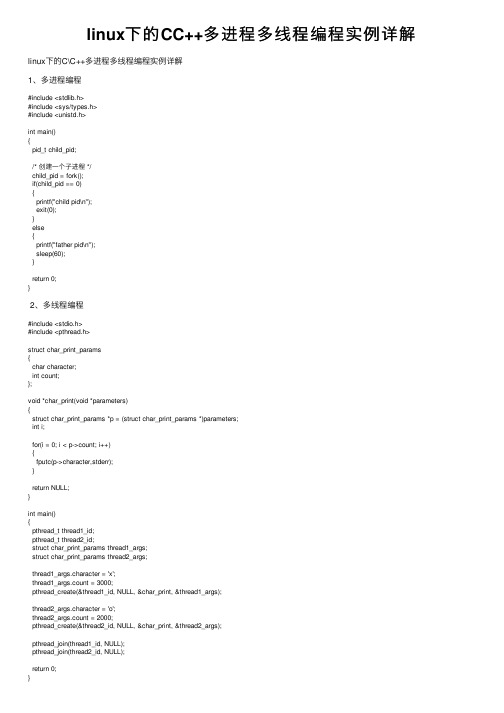
linux下的CC++多进程多线程编程实例详解linux下的C\C++多进程多线程编程实例详解1、多进程编程#include <stdlib.h>#include <sys/types.h>#include <unistd.h>int main(){pid_t child_pid;/* 创建⼀个⼦进程 */child_pid = fork();if(child_pid == 0){printf("child pid\n");exit(0);}else{printf("father pid\n");sleep(60);}return 0;}2、多线程编程#include <stdio.h>#include <pthread.h>struct char_print_params{char character;int count;};void *char_print(void *parameters){struct char_print_params *p = (struct char_print_params *)parameters;int i;for(i = 0; i < p->count; i++){fputc(p->character,stderr);}return NULL;}int main(){pthread_t thread1_id;pthread_t thread2_id;struct char_print_params thread1_args;struct char_print_params thread2_args;thread1_args.character = 'x';thread1_args.count = 3000;pthread_create(&thread1_id, NULL, &char_print, &thread1_args);thread2_args.character = 'o';thread2_args.count = 2000;pthread_create(&thread2_id, NULL, &char_print, &thread2_args);pthread_join(thread1_id, NULL);pthread_join(thread2_id, NULL);return 0;}3、线程同步与互斥1)、互斥pthread_mutex_t mutex;pthread_mutex_init(&mutex, NULL);/*也可以⽤下⾯的⽅式初始化*/pthread_mutex_t mutex = PTHREAD_MUTEX_INITIALIZER; pthread_mutex_lock(&mutex);/* 互斥 */thread_flag = value;pthread_mutex_unlock(&mutex);2)、条件变量int thread_flag = 0;pthread_mutex_t mutex;pthread_cond_t thread_flag_cv;\void init_flag(){pthread_mutex_init(&mutex, NULL);pthread_cond_init(&thread_flag_cv, NULL);thread_flag = 0;}void *thread_function(void *thread_flag){while(1){pthread_mutex_lock(&mutex);while(thread_flag != 0 ){pthread_cond_wait(&thread_flag_cv, &mutex);}pthread_mutex_unlock(&mutex);do_work();}return NULL;}void set_thread_flag(int flag_value){pthread_mutex_lock(&mutex);thread_flag = flag_value;pthread_cond_signal(&thread_flag_cv);pthread_mutex_unlock(&mutex);}感谢阅读,希望能帮助到⼤家,谢谢⼤家对本站的⽀持!。
c语言多线程编程实例

c语言多线程编程实例C语言多线程编程实例多线程编程是一种并发编程的方式,它可以让程序同时执行多个任务,提高程序的效率和响应速度。
C语言是一种广泛使用的编程语言,也支持多线程编程。
本文将介绍一些C语言多线程编程的实例,帮助读者更好地理解和掌握多线程编程技术。
1. 创建线程在C语言中,可以使用pthread库来创建线程。
下面是一个简单的例子,创建一个线程并让它输出一段文字:```#include <stdio.h>#include <pthread.h>void* thread_func(void* arg){printf("Hello, world!\n");return NULL;}int main(){pthread_t tid;pthread_create(&tid, NULL, thread_func, NULL);pthread_join(tid, NULL);return 0;}```在上面的代码中,我们定义了一个函数thread_func,它将作为线程的入口函数。
在main函数中,我们使用pthread_create函数创建了一个线程,并将thread_func作为入口函数。
然后使用pthread_join 函数等待线程结束。
2. 线程同步在多线程编程中,线程之间的同步非常重要。
下面是一个例子,演示如何使用互斥锁来保护共享资源:```#include <stdio.h>#include <pthread.h>int count = 0;pthread_mutex_t mutex;void* thread_func(void* arg){pthread_mutex_lock(&mutex);count++;printf("Thread %d: count = %d\n", (int)arg, count); pthread_mutex_unlock(&mutex);return NULL;}int main(){pthread_t tid1, tid2;pthread_mutex_init(&mutex, NULL);pthread_create(&tid1, NULL, thread_func, (void*)1); pthread_create(&tid2, NULL, thread_func, (void*)2); pthread_join(tid1, NULL);pthread_join(tid2, NULL);pthread_mutex_destroy(&mutex);return 0;}```在上面的代码中,我们定义了一个全局变量count,它将被两个线程同时访问。
并发运行机制及实现方法
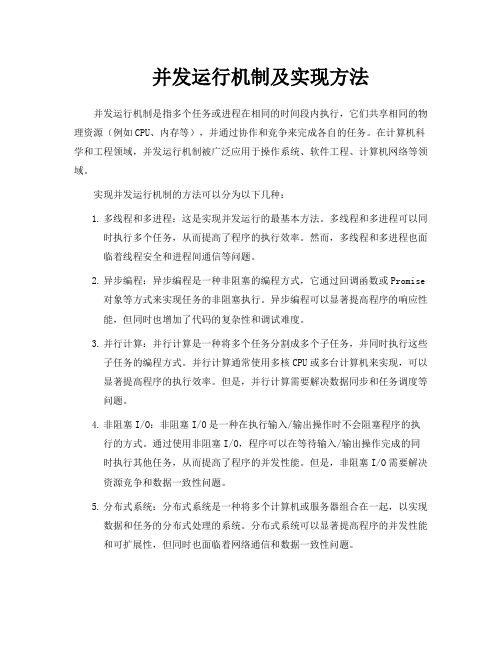
并发运行机制及实现方法并发运行机制是指多个任务或进程在相同的时间段内执行,它们共享相同的物理资源(例如CPU、内存等),并通过协作和竞争来完成各自的任务。
在计算机科学和工程领域,并发运行机制被广泛应用于操作系统、软件工程、计算机网络等领域。
实现并发运行机制的方法可以分为以下几种:1.多线程和多进程:这是实现并发运行的最基本方法。
多线程和多进程可以同时执行多个任务,从而提高了程序的执行效率。
然而,多线程和多进程也面临着线程安全和进程间通信等问题。
2.异步编程:异步编程是一种非阻塞的编程方式,它通过回调函数或Promise对象等方式来实现任务的非阻塞执行。
异步编程可以显著提高程序的响应性能,但同时也增加了代码的复杂性和调试难度。
3.并行计算:并行计算是一种将多个任务分割成多个子任务,并同时执行这些子任务的编程方式。
并行计算通常使用多核CPU或多台计算机来实现,可以显著提高程序的执行效率。
但是,并行计算需要解决数据同步和任务调度等问题。
4.非阻塞I/O:非阻塞I/O是一种在执行输入/输出操作时不会阻塞程序的执行的方式。
通过使用非阻塞I/O,程序可以在等待输入/输出操作完成的同时执行其他任务,从而提高了程序的并发性能。
但是,非阻塞I/O需要解决资源竞争和数据一致性问题。
5.分布式系统:分布式系统是一种将多个计算机或服务器组合在一起,以实现数据和任务的分布式处理的系统。
分布式系统可以显著提高程序的并发性能和可扩展性,但同时也面临着网络通信和数据一致性问题。
在实际应用中,根据不同的需求和场景,可以选择不同的实现并发运行机制的方法。
例如,对于需要处理大量并发请求的Web应用程序,可以使用多线程或异步编程等技术;对于需要处理大规模数据的科学计算或机器学习应用,可以使用并行计算或分布式系统等技术。
总之,并发运行机制是现代计算机系统中的重要组成部分,它可以提高程序的执行效率和响应性能,但同时也需要解决许多技术难题。
C语言的多核编程与并行执行
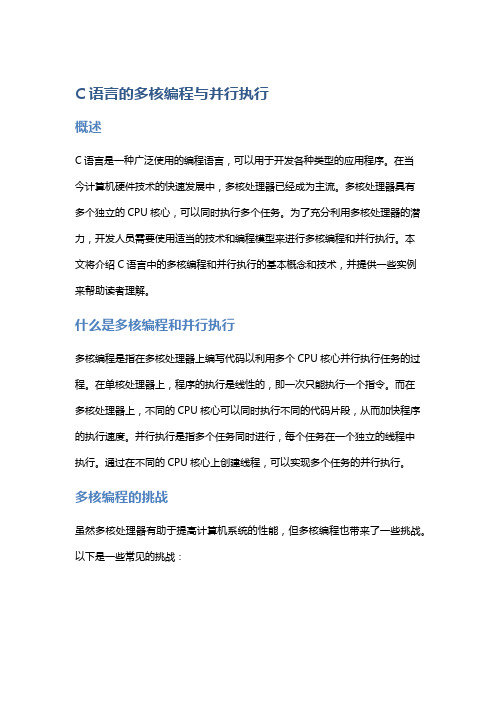
C语言的多核编程与并行执行概述C语言是一种广泛使用的编程语言,可以用于开发各种类型的应用程序。
在当今计算机硬件技术的快速发展中,多核处理器已经成为主流。
多核处理器具有多个独立的CPU核心,可以同时执行多个任务。
为了充分利用多核处理器的潜力,开发人员需要使用适当的技术和编程模型来进行多核编程和并行执行。
本文将介绍C语言中的多核编程和并行执行的基本概念和技术,并提供一些实例来帮助读者理解。
什么是多核编程和并行执行多核编程是指在多核处理器上编写代码以利用多个CPU核心并行执行任务的过程。
在单核处理器上,程序的执行是线性的,即一次只能执行一个指令。
而在多核处理器上,不同的CPU核心可以同时执行不同的代码片段,从而加快程序的执行速度。
并行执行是指多个任务同时进行,每个任务在一个独立的线程中执行。
通过在不同的CPU核心上创建线程,可以实现多个任务的并行执行。
多核编程的挑战虽然多核处理器有助于提高计算机系统的性能,但多核编程也带来了一些挑战。
以下是一些常见的挑战:数据共享和同步在多核编程中,多个线程可以同时访问和修改共享的数据。
这可能导致数据竞争和不一致的结果。
为了解决这个问题,开发人员需要使用同步机制来确保线程之间的正确协同工作,例如使用互斥锁、条件变量等。
负载平衡在多核处理器上,任务的负载应该平衡在不同的CPU核心上。
如果负载不平衡,某些核心可能一直处于空闲状态,而其他核心却忙于处理更多的任务。
开发人员需要设计和实现合适的调度算法来平衡任务的负载。
可扩展性多核编程要求程序能够有效地扩展到多个CPU核心上。
如果程序的设计和实现不具备可扩展性,增加CPU核心的数量可能无法提高性能。
开发人员需要使用可扩展的算法和数据结构来实现可扩展的程序。
C语言中的多核编程技术C语言提供了一些用于多核编程的技术和库。
以下是一些常用的技术:线程库C语言提供了线程库(pthread)来创建和管理线程。
线程库提供了创建线程、销毁线程、同步线程等功能。
C语言多线程操作

C语⾔多线程操作多线程是多任务处理的⼀种特殊形式,多任务处理允许让电脑同时运⾏两个或两个以上的程序。
⼀般情况下,两种类型的多任务处理:基于进程和基于线程。
基于进程的多任务处理是程序的并发执⾏。
基于线程的多任务处理是同⼀程序的⽚段的并发执⾏。
多线程程序包含可以同时运⾏的两个或多个部分。
这样的程序中的每个部分称为⼀个线程,每个线程定义了⼀个单独的执⾏路径。
本教程假设您使⽤的是 Linux 操作系统,我们要使⽤ POSIX 编写多线程 C++ 程序。
POSIX Threads 或 Pthreads 提供的 API 可在多种类 Unix POSIX 系统上可⽤,⽐如 FreeBSD、NetBSD、GNU/Linux、Mac OS X 和 Solaris。
下⾯的程序,我们可以⽤它来创建⼀个POSIX 线程:#include <pthread.h>pthread_create (thread, attr, start_routine, arg)在这⾥,pthread_create 创建⼀个新的线程,并让它可执⾏。
下⾯是关于参数的说明:参数描述thread指向线程标识符指针。
attr⼀个不透明的属性对象,可以被⽤来设置线程属性。
您可以指定线程属性对象,也可以使⽤默认值 NULL。
start_routine线程运⾏函数起始地址,⼀旦线程被创建就会执⾏。
arg运⾏函数的参数。
它必须通过把引⽤作为指针强制转换为 void 类型进⾏传递。
如果没有传递参数,则使⽤ NULL。
创建线程成功时,函数返回 0,若返回值不为 0 则说明创建线程失败。
使⽤下⾯的程序,我们可以⽤它来终⽌⼀个 POSIX 线程:#include <pthread.h>pthread_exit (status)在这⾥,pthread_exit ⽤于显式地退出⼀个线程。
通常情况下,pthread_exit() 函数是在线程完成⼯作后⽆需继续存在时被调⽤。
Linux下c语言多线程编程

Linux下c语⾔多线程编程引⾔ 线程(thread)技术早在60年代就被提出,但真正应⽤多线程到中去,是在80年代中期,solaris是这⽅⾯的佼佼者。
传统的Unix也⽀持线程的概念,但是在⼀个进程(process)中只允许有⼀个线程,这样多线程就意味着多进程。
现在,多 为什么有了进程的概念后,还要再引⼊线程呢?使⽤多线程到底有哪些好处?什么的系统应该选⽤多线程?我们⾸先必须回答这些问题。
使⽤多线程的理由之⼀是和进程相⽐,它是⼀种⾮常"节俭"的多任务操作⽅式。
我们知道,在Linux系统下,启动⼀个新的进程必须分配给它独⽴的地址空间,建⽴众多的数据表来维护它的代码段、堆栈段和数据段,这是⼀种"昂贵"的多任务⼯作⽅式。
⽽运⾏于⼀个进程中的多个线程,它们彼此之间使⽤相同的地址空间,共享⼤部分数据,启动⼀个线程所花费的空间远远⼩于启动⼀个进程所花费的空间,⽽且,线程间彼此切换所需的时间也远远⼩于进程间切换所需要的时间。
使⽤多线程的理由之⼆是线程间⽅便的机制。
对不同进程来说,它们具有独⽴的数据空间,要进⾏数据的传递只能通过通信的⽅式进⾏,这种⽅式不仅费时,⽽且很不⽅便。
线程则不然,由于同⼀进程下的线程之间共享数据空间,所以⼀个线程的数据可以直接为其它线程所⽤,这不仅快捷,⽽且⽅便。
当然,数据的共享也带来其他⼀些问题,有的变量不能同时被两个线程所修改,有的⼦程序中声明为static的数据更有可能给多线程程序带来灾难性的打击,这些正是编写多线程程序时最需要注意的地⽅。
除了以上所说的优点外,不和进程⽐较,多线程程序作为⼀种多任务、并发的⼯作⽅式,当然有以下的优点: 1) 提⾼应⽤程序响应。
这对图形界⾯的程序尤其有意义,当⼀个操作耗时很长时,整个系统都会等待这个操作,此时程序不会响应、、菜单的操作,⽽使⽤多线程技术,将耗时长的操作(time consuming)置于⼀个新的线程,可以避免这种尴尬的情况。
c语言多线程的三种实现方式

c语言多线程的三种实现方式1 C语言多线程实现C语言语言既可以用于创建单线程应用程序,也可以用于创建多线程应用程序。
它的多线程实现有三种方式:POSIX线程库(Pthread),Windows API,以及共享内存。
1.1 POSIX线程库(Pthread)POSIX线程库(Pthread)是Linux系统的一种线程API,它由标准POSIX提供,以实现多线程程序设计。
它提供许多函数用于创建、销毁线程,设置线程属性,等待线程完成以及通信功能等。
Pthread在多线程编程中被使用广泛,它更易于操纵,可以让多线程编程更加容易和有趣。
1.2 Windows APIWindows API 也是可用于C语言多线程编程的方式之一。
Windows API提供许多功能:创建线程,挂起线程,等待线程结束,分离线程,设置线程优先级等等。
Windows API也提供了很多函数和常量用于控制线程。
它与POSIX线程库不同,Windows API不使用POSIX线程库,而使用Windows API实现多线程程序时,同一应用程序可以具有多个线程。
1.3 共享内存共享内存是指多个进程可以访问同一个内存区域,从而使它们能够共享数据,实现常见的多线程编程任务。
在C语言中,可以使用mmap()函数将共享内存映射成文件描述符,在一定范围内允许多个进程对共享内存的随机读写访问。
这是一种实现多线程的方式,能够极大地提高程序的效率。
以上就是C语言中多线程实现的三种方式。
POSIX线程库(Pthread)可以简易实现,更能让多线程编程更加容易和有趣;Windows API也可以实现多线程编程,可以让同一应用程序有多个线程;共享内存是一种实现多线程的方法,能够极大地提高程序的效率。
python 多进程、多线程、多协程应用场景实例详解

python 多进程、多线程、多协程应用场景实例详解(实用版)目录1.Python 多进程、多线程、多协程的概念及区别2.多进程的应用场景实例3.多线程的应用场景实例4.多协程的应用场景实例5.总结正文Python 是一款功能强大的编程语言,其中多进程、多线程和多协程是实现并发编程的重要方式。
它们各自有着不同的应用场景和优缺点,下面我们将通过实例来详细了解它们的使用场景。
一、Python 多进程、多线程、多协程的概念及区别多进程是指在一个程序中同时运行多个进程,每个进程都有自己的独立内存空间和系统资源,它们之间通过进程间通信来交换数据。
多进程适用于 CPU 密集型任务,可以利用多核 CPU 提高程序的执行效率。
多线程是指在一个进程中同时运行多个线程,每个线程共享进程的内存空间和系统资源,它们之间通过共享内存来交换数据。
多线程可以提高程序的执行效率,特别是对于 I/O 密集型任务。
多协程是一种轻量级的并发编程方式,它既不需要切换 CPU,也不需要切换内存,可以在一个线程内部实现多个任务的并发执行。
多协程适用于处理大量 I/O 密集型任务。
二、多进程的应用场景实例假设我们有一个 CPU 密集型任务,需要对大量数据进行计算,我们可以使用多进程来实现并发处理。
例如,我们可以将任务分解为多个子任务,每个子任务由一个进程来完成,这样多个进程可以同时运行,大大提高计算效率。
三、多线程的应用场景实例假设我们有一个I/O密集型任务,需要对大量数据进行读写操作,我们可以使用多线程来实现并发处理。
例如,我们可以使用多个线程同时进行读写操作,这样多个线程可以同时运行,大大提高I/O操作的效率。
四、多协程的应用场景实例假设我们有一个大量I/O密集型任务,需要对大量数据进行异步读写操作,我们可以使用多协程来实现并发处理。
例如,我们可以使用多个协程同时进行异步读写操作,这样多个协程可以同时在一个线程内部执行,大大提高程序的执行效率。
多线程程序c语言
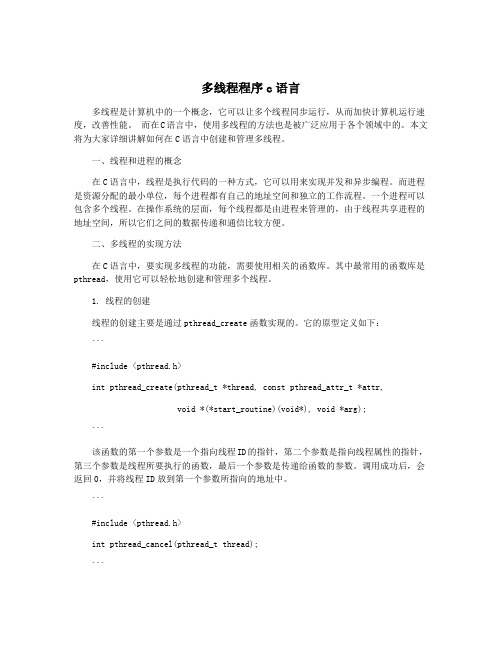
多线程程序c语言多线程是计算机中的一个概念,它可以让多个线程同步运行,从而加快计算机运行速度,改善性能。
而在C语言中,使用多线程的方法也是被广泛应用于各个领域中的。
本文将为大家详细讲解如何在C语言中创建和管理多线程。
一、线程和进程的概念在C语言中,线程是执行代码的一种方式,它可以用来实现并发和异步编程。
而进程是资源分配的最小单位,每个进程都有自己的地址空间和独立的工作流程。
一个进程可以包含多个线程。
在操作系统的层面,每个线程都是由进程来管理的,由于线程共享进程的地址空间,所以它们之间的数据传递和通信比较方便。
二、多线程的实现方法在C语言中,要实现多线程的功能,需要使用相关的函数库。
其中最常用的函数库是pthread,使用它可以轻松地创建和管理多个线程。
1. 线程的创建线程的创建主要是通过pthread_create函数实现的。
它的原型定义如下:```#include <pthread.h>int pthread_create(pthread_t *thread, const pthread_attr_t *attr,void *(*start_routine)(void*), void *arg);```该函数的第一个参数是一个指向线程ID的指针,第二个参数是指向线程属性的指针,第三个参数是线程所要执行的函数,最后一个参数是传递给函数的参数。
调用成功后,会返回0,并将线程ID放到第一个参数所指向的地址中。
```#include <pthread.h>int pthread_cancel(pthread_t thread);```该函数的参数是要撤销的线程ID。
调用成功后,函数会直接将指定的线程终止掉,并释放它所占用的资源。
三、多线程的应用场景在C语言中,多线程的应用场景非常广泛,下面分别介绍几种典型的应用场景:1. 网络编程在网络编程中,要同时处理多个客户端请求,这时使用多线程可以使程序并发执行,效率更高。
《用C语言实现高效的多线程》

《用C语言实现高效的多线程》
本文阐述了如何使用C语言实现高效的多线程,来提高程序
性能。
第一,我们首先要讨论多线程。
多线程是指程序中有多个可以同时运行的部分,即多个线程可以分别在不同的CPU中执行
不同的任务。
在C语言中,可以使用POSIX线程库(Pthread)来实现多线程。
第二,要了解如何优化多线程程序的性能。
优化多线程程序的一个主要方法是减少线程间的竞争。
通常我们可以通过以下方式减少线程间的竞争:1)使用原子操作;2)使用锁;3)使
用消息传递;4)使用数据分区。
此外,程序的性能也可能受到硬件平台的影响。
针对不同的平台,我们可以采用不同的优化技巧。
例如,在多核CPU上,
主要是利用多核来增加程序的性能,这就要求程序有足够的并行可能性。
第三,在实际的应用程序中,我们应该特别考虑如何在C语
言中设计并行程序来提高程序性能。
在设计并行程序时,主要考虑如何将程序分解成多个独立的线程,以实现最大的利用多核处理器的性能,还要考虑线程间的通信和同步问题以避免数据竞争。
总之,使用C语言实现高效的多线程主要包括:首先,利用POSIX线程库(Pthread)实现多线程;其次,通过减少线程
间的竞争和考虑硬件平台的性能特点来优化多线程程序;最后,在实际的应用程序中,我们应该设计并行程序来充分利用多核处理器的性能,并考虑线程间的通信与同步问题。
什么是并发编程

什么是并发编程一、引言随着计算机硬件性能的不断提高,单线程下的程序已经无法满足用户日益增长的需求,程序员们面临着一个新的编程范式——并发编程。
并发编程是指在一个程序中同时执行多个独立的任务的编程方式,它相对于顺序执行的程序,可以使程序效率更高,响应更快。
因此,本文旨在介绍并发编程的定义、必要性、原理以及实现方式等内容,并探讨并发编程的优缺点。
二、并发编程的定义并发是指多个独立的任务在同时进行,而编程则是通过代码进行工作的过程。
因此,将这两个概念结合起来,我们可以得到并发编程的定义:在一个程序中同时执行多个独立的任务的编程方式。
三、并发编程的必要性与顺序执行的程序相比,使用并发编程能够使程序更高效、更快速,提高用户体验。
因此,下面介绍并发编程的必要性:(一)提高系统的并发度并发编程可以将一个任务拆解成多个独立的子任务,充分利用CPU 的多核能力,并发执行子任务,提高系统的并发度。
以往的单线程程序只能在单个CPU核上运行,因此很难发挥出CPU的全部性能。
但是,使用并发编程可以充分利用CPU的多核能力,让系统在相同时间内可以处理更多的任务。
(二)增强程序的响应能力并发编程可以让系统同时处理多个任务,响应速度更快。
在顺序执行程序中,一个任务需要完成后才能开始下一个任务,而在并发编程中,多个任务可以同时运行,可以让系统更快地响应用户的请求。
例如,Web服务器可以并行处理多个Web请求,提高响应速度。
(三)提高程序的可扩展性并发编程可以充分利用多核CPU,同时运行多个任务,可以让程序更容易扩展。
当需要处理更多请求时,可以通过增加线程数等方式提升程序的处理速度和吞吐量。
(四)实现程序的复杂性并发编程可以让程序更好地处理逻辑上互不依赖的任务,通过将任务拆分成多个子任务,让实现程序的复杂性变得简单。
例如,一个电商网站需要查询商品库存并进行下单,这两个操作是互不依赖的,使用并发编程可以同时执行这两个操作,提高程序的效率。
《如何使用C语言实现多线程编程?》

《如何使用C语言实现多线程编程?》使用C语言实现多线程编程是一种强大的方法,它可以使程序更加高效、多样化,并可以完成更复杂的任务。
本文将介绍如何使用C语言实现多线程编程。
一、准备工作在开始使用C语言实现多线程编程之前,需要准备一些相关的资源,其中包括编程所需的适当的硬件和软件设备,多线程同步编程所需的程序库,以及使用C语言实现多线程编程所需的支持库。
二、编写并启动多线程程序使用C语言实现多线程编程的关键是,开发人员需要利用程序库和支持库,编写实现具体功能的代码。
比如,开发人员可以利用POSIX线程库,编写使用pthread_create()函数的多线程程序;可以利用Windows线程库,编写使用CreateThread()函数的多线程程序;也可以利用OpenMP线程库,编写使用omp_set_num_threads()函数的多线程程序。
三、运行多线程程序完成了多线程程序的编写,开发人员需要使用C语言的编译器,将多线程程序编译为可执行程序,然后使用操作系统的任务管理器,将多线程程序载入内存,进而启动多线程程序,使其正常运行。
四、检查多线程程序的运行状态开发人员可以使用操作系统提供的任务管理器,对多线程程序的运行状态进行实时检查,以确保多线程程序的正确性,并尽量避免出现无意义的多线程并发运行,以及多线程状态的混乱。
五、在多线程程序中使用同步如果多线程程序中的多个线程要访问同一个共享变量,开发人员需要使用同步技术,保证多个线程之间的数据操作是正确和可靠的。
支持这种技术的有Mutexes(互斥)、Semaphores(信号量)、Condition Variables(条件变量),以及Read/Write Lock(读/写锁)等。
总之,使用C语言实现多线程编程可以使程序更加高效、多样化,并可以完成更复杂的任务。
开发人员需要做好准备工作,编写并启动多线程程序,运行多线程程序,检查多线程程序的运行状态,以及在多线程程序中使用同步,来实现多线程编程。
c 语言需求分析报告
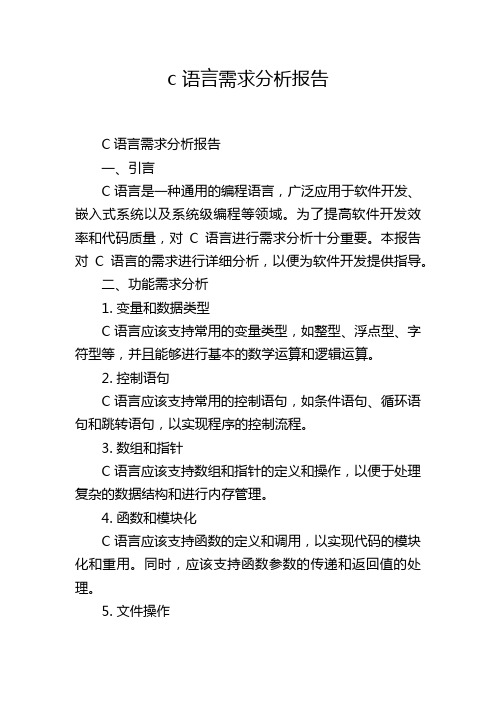
c 语言需求分析报告C语言需求分析报告一、引言C语言是一种通用的编程语言,广泛应用于软件开发、嵌入式系统以及系统级编程等领域。
为了提高软件开发效率和代码质量,对C语言进行需求分析十分重要。
本报告对C语言的需求进行详细分析,以便为软件开发提供指导。
二、功能需求分析1. 变量和数据类型C语言应该支持常用的变量类型,如整型、浮点型、字符型等,并且能够进行基本的数学运算和逻辑运算。
2. 控制语句C语言应该支持常用的控制语句,如条件语句、循环语句和跳转语句,以实现程序的控制流程。
3. 数组和指针C语言应该支持数组和指针的定义和操作,以便于处理复杂的数据结构和进行内存管理。
4. 函数和模块化C语言应该支持函数的定义和调用,以实现代码的模块化和重用。
同时,应该支持函数参数的传递和返回值的处理。
5. 文件操作C语言应该支持对文件的读写操作,以实现数据的持久化和文件的处理。
6. 扩展性C语言应该具有良好的扩展性,可以方便地用来编写大型软件系统。
应该支持模块化的设计和代码的重用。
三、性能需求分析1. 执行效率C语言应该能够生成高效的机器码,以保证程序的执行效率。
同时,应该提供优化选项,以便根据具体场景改善性能。
2. 内存占用C语言应该保证尽可能少的内存占用,以提高系统的资源利用率。
3. 并发性能C语言应该支持多线程和多进程的编程模型,以满足多核处理器的并发需求。
四、安全性需求分析1. 内存安全C语言应该提供内存安全的编程机制,以防止缓冲区溢出和内存泄漏等问题。
2. 异常处理C语言应该支持异常处理机制,以应对程序运行时的异常情况。
3. 安全漏洞C语言应该提供一定的安全编程指南和警告机制,以帮助程序员避免常见的安全漏洞。
五、可靠性需求分析1. 数据完整性C语言应该提供数据完整性的保障机制,以防止数据在读写过程中的损坏。
2. 错误处理C语言应该提供良好的错误处理机制,包括错误码和错误信息的返回,以便于程序员进行错误处理。
- 1、下载文档前请自行甄别文档内容的完整性,平台不提供额外的编辑、内容补充、找答案等附加服务。
- 2、"仅部分预览"的文档,不可在线预览部分如存在完整性等问题,可反馈申请退款(可完整预览的文档不适用该条件!)。
- 3、如文档侵犯您的权益,请联系客服反馈,我们会尽快为您处理(人工客服工作时间:9:00-18:30)。
C语言并发编程多线程和多进程C语言并发编程:多线程和多进程
编程中的并发是指程序在同一时间可以执行多个任务或进程。
并发编程可以提高程序的效率和性能,使得程序可以同时处理多个任务,实现高度的并行化。
在C语言中,实现并发编程的两种常见方式是多线程和多进程。
一、多线程
多线程是指在一个进程中创建多个线程,每个线程可以并行执行不同的任务。
C语言提供了pthread库来支持多线程编程。
下面简要介绍多线程的一些核心概念和用法:
1. 线程创建与结束
通过pthread_create函数来创建线程,并且使用pthread_join函数等待线程结束。
示例代码如下:
```c
#include <stdio.h>
#include <pthread.h>
void *thread_func(void *arg) {
// 线程执行的代码
return NULL;
}
int main() {
pthread_t tid;
pthread_create(&tid, NULL, thread_func, NULL);
// 其他主线程执行的代码
pthread_join(tid, NULL);
return 0;
}
```
2. 线程同步与互斥
多线程执行过程中,可能会出现共享资源的竞争问题。
为了避免竞争,需要使用互斥锁来保护共享资源的访问。
示例代码如下: ```c
#include <stdio.h>
#include <pthread.h>
int counter = 0;
pthread_mutex_t mutex;
void *thread_func(void *arg) {
pthread_mutex_lock(&mutex);
counter++;
pthread_mutex_unlock(&mutex);
return NULL;
}
int main() {
pthread_t tid1, tid2;
pthread_mutex_init(&mutex, NULL);
pthread_create(&tid1, NULL, thread_func, NULL);
pthread_create(&tid2, NULL, thread_func, NULL);
pthread_join(tid1, NULL);
pthread_join(tid2, NULL);
printf("Counter value: %d\n", counter);
pthread_mutex_destroy(&mutex);
return 0;
}
```
3. 线程间通信
多个线程之间可以通过共享内存进行通信。
C语言提供了一些线
程间共享内存的机制,如全局变量、线程局部存储等。
示例代码如下:
#include <stdio.h>
#include <pthread.h>
int number = 0; // 全局变量
void *thread_func1(void *arg) {
number = 10;
return NULL;
}
void *thread_func2(void *arg) {
printf("Value from thread 1: %d\n", number);
return NULL;
}
int main() {
pthread_t tid1, tid2;
pthread_create(&tid1, NULL, thread_func1, NULL); pthread_create(&tid2, NULL, thread_func2, NULL); pthread_join(tid1, NULL);
pthread_join(tid2, NULL);
return 0;
```
二、多进程
多进程是指在一个程序中创建多个子进程,每个子进程可以并行执
行不同的任务。
C语言提供了fork函数和exec函数来支持多进程编程。
下面简要介绍多进程的一些核心概念和用法:
1. 进程创建与结束
通过fork函数来创建子进程,并且通过exit函数来结束进程。
示
例代码如下:
```c
#include <stdio.h>
#include <stdlib.h>
#include <sys/types.h>
#include <sys/wait.h>
#include <unistd.h>
int main() {
pid_t pid;
pid = fork();
if (pid < 0) {
printf("Fork error\n");
exit(1);
} else if (pid == 0) {
// 子进程执行的代码
exit(0);
} else {
// 父进程执行的代码
wait(NULL);
printf("Child process finished\n");
}
return 0;
}
```
2. 进程间通信
多个进程之间可以通过管道、共享内存、信号等机制进行通信。
C语言提供了一些进程间通信的函数和结构体,如pipe函数、shmget 函数、signal函数等。
示例代码如下:
```c
#include <stdio.h>
#include <stdlib.h>
#include <unistd.h>
#include <sys/types.h>
#include <sys/ipc.h>
#include <sys/shm.h>
#define SHM_SIZE 1024
int main() {
int shmid;
char *shmaddr;
shmid = shmget(IPC_PRIVATE, SHM_SIZE, IPC_CREAT | 0666); if (shmid == -1) {
printf("Shared memory allocation error\n");
exit(1);
}
shmaddr = shmat(shmid, NULL, 0);
if (shmaddr == (char *) -1) {
printf("Shared memory attachment error\n");
exit(1);
}
sprintf(shmaddr, "Hello, shared memory!");
printf("Message from shared memory: %s\n", shmaddr);
shmdt(shmaddr);
shmctl(shmid, IPC_RMID, NULL);
return 0;
}
```
综上所述,C语言提供了多线程和多进程的编程支持,可以实现并发编程,提高程序的效率和性能。
通过合理使用多线程和多进程,可以使程序在同一时间处理多个任务或进程,达到高度的并行化。
在编写并发程序时,需要注意线程或进程之间的同步与互斥,以及合适的通信机制,以确保程序的正确性和稳定性。
